Are you a Quiet Speculation member?
If not, now is a perfect time to join up! Our powerful tools, breaking-news analysis, and exclusive Discord channel will make sure you stay up to date and ahead of the curve.
Welcome back, folks!
I had intended to conclude the Ixalan rotation series this week, but Hour of Devastation reached its financial low during the first week of August, and so I want to write about speculating on Hour of Devastation singles before the set price climbs too high. Recall that one of the primary speculation methods I employ is to speculate on cards in sets that are at their lowest value since that minimizes risk (and theoretically maximizes profit potential, although for me personally that's less of a concern than risk minimization).
I was really surprised by how well Hour of Devastation maintained its value. I had predicted that the Hour of Devastation would reach a 37.00- to 40.00-tix set value, but in truth it never did. It reached 45.00 tix during the first week of August, and ever since then has been fluctuating between 47.00 and 57.00 tix. I suspect that many of you have felt the same way I have about the prices of Hour of Devastation cards – like the rent in New York, they're too damn high! After doing a little bit of research I figured out the most probable cause - the disparity between the set's digital value and paper value is so great that a substantially larger amount of Hour of Devastation sets are getting redeemed than normal. This, combined with the lower supply of small sets in general, demands that we look at Hour of Devastation card prices in a different light.
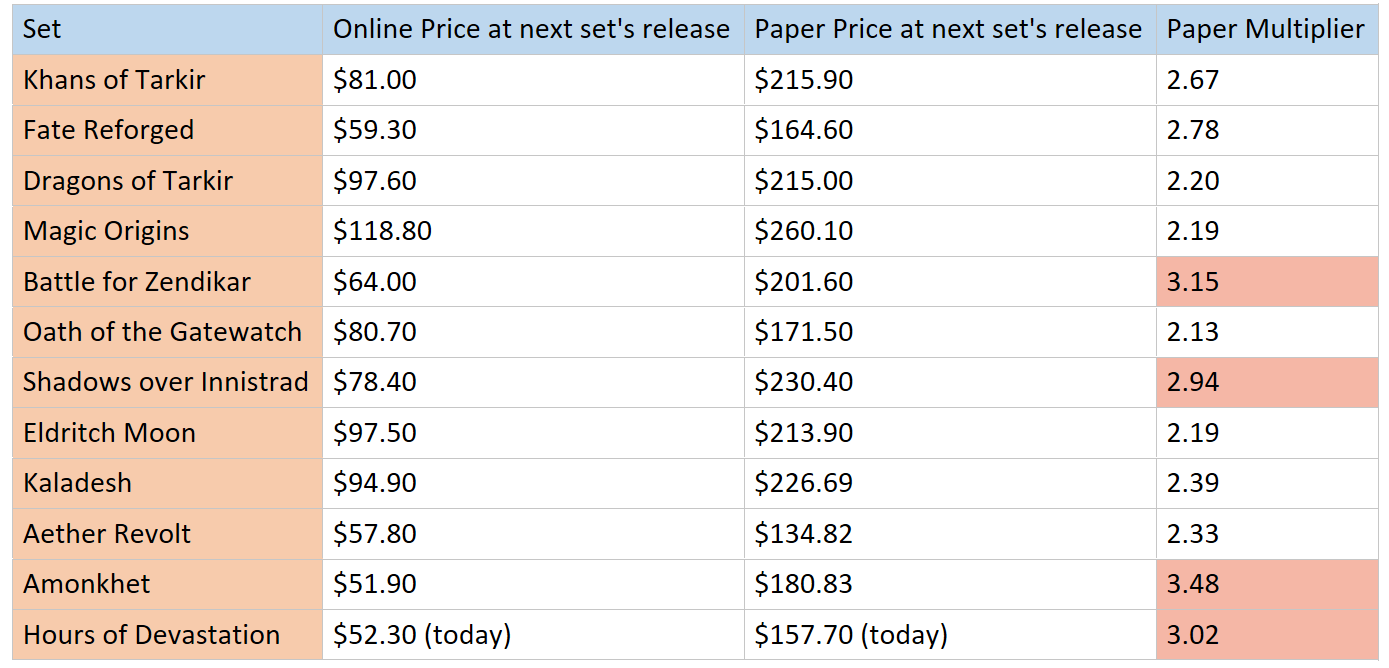
Amonkhet and Hour of Devastation both have very high paper multipliers, meaning that the value of the paper cards is higher than usual when compared to the digital cards. Usually the value of a paper set is 2 to 2.5 times the value of a digital set, but occasionally it is closer to triple the value. In Amonkhet block's case, it is halfway between triple and quadruple! This means we can expect Amonkhet and Hour of Devastation to be redeemed more than usual, leading to a more limited supply online. This means that the online value of Amonkhet and Hour of Devastation mythics will be significantly higher than normal, and that of the rares will be higher as well. Because I did not fully appreciate this fact until I began to do research for this article, I did significantly less investing in Amonkhet and Hour of Devastation cards than in Kaladesh block cards. The prices just seemed so high, and I kept expecting them to go lower.
As I did with Amonkhet, I want to share my thoughts on my favorite speculation targets. Remember that, in general, there will never be a better, more forgiving time to buy in on Hour of Devastation cards. In this article, I will focus on the more expensive cards, and in part two, I will focus on cheaper cards.
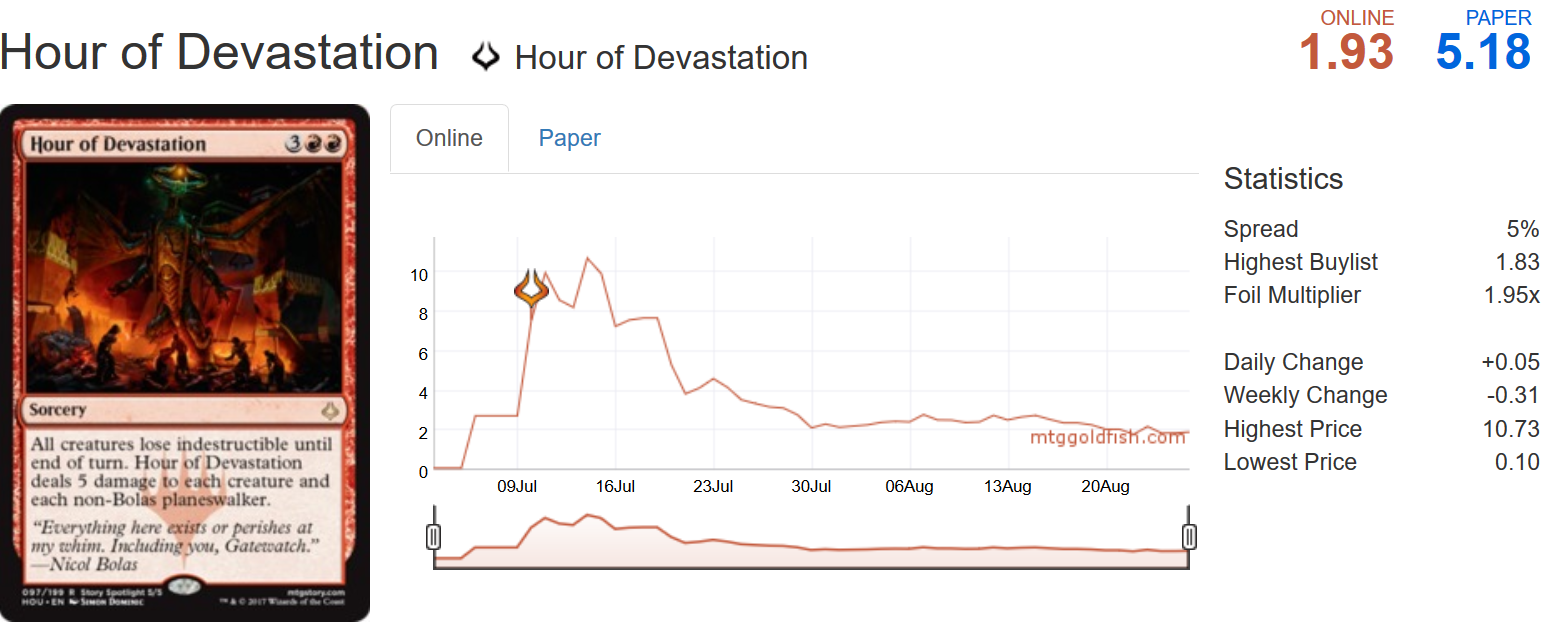
Hour of Devastation is an excellent sweeper, one too slow for Hour of Devastation Standard to reach all-star status, but one that is well-suited to thrive in a midrange-dominated Standard. Unlike other sweepers surviving rotation, Hour of Devastation deals with Hazoret, the Fervent, Rhonas, the Indomitable and Crested Sunmare, should that card find a competitive home. What Hour of Devastation doesn't permanently deal with are Vehicles like Heart of Kiran and the Hour of Devastation Gods. At any rate, I think that this card will have some Standard formats where it doesn't shine and others where it does, and when it does it should be a 3.00- to 5.00-tix card.
Recommended buy price: 1.75 to 2.00 tix
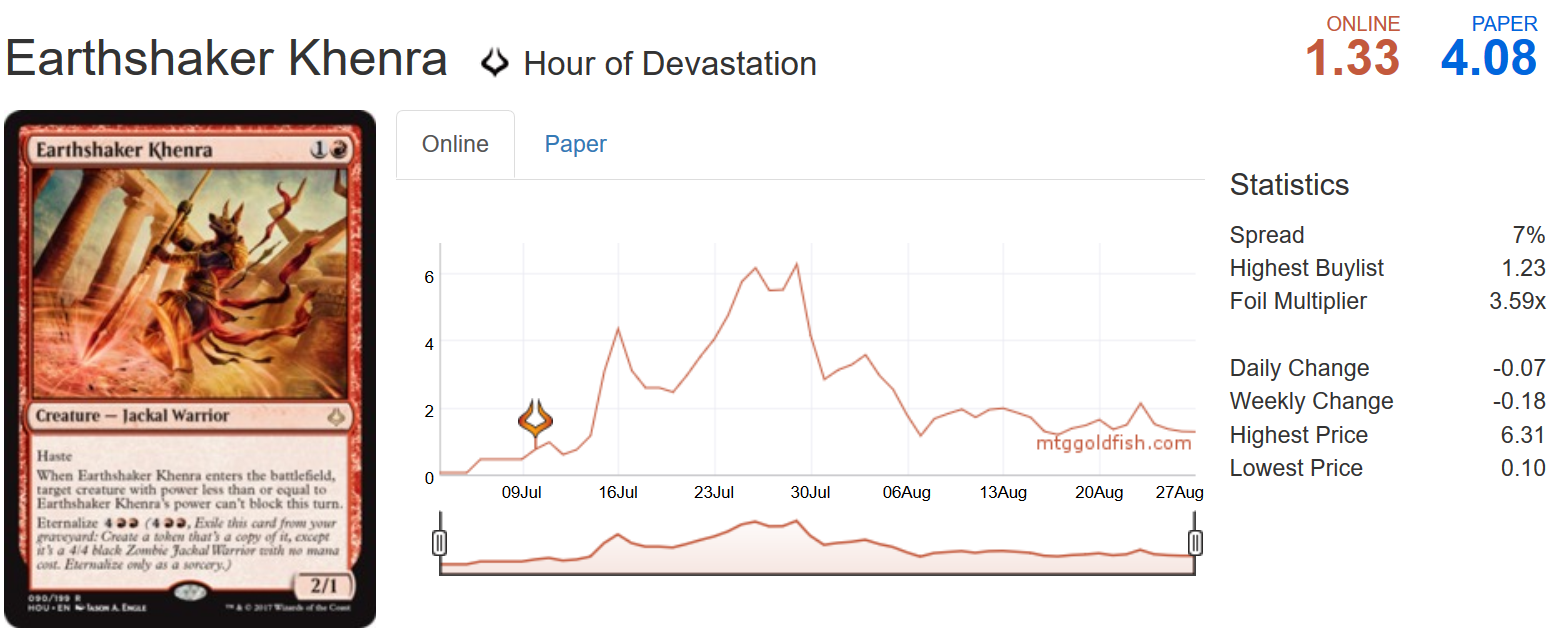
Earthshaker Khenra will be a core piece of any Red Deck Wins strategy and most likely a core piece of any Red deck that slants heavily aggressive until it rotates. Sitting at 1.40 tix, Earthshaker Khenra is one of the only cards in Hour of Devastation I feel has been undervalued for a long time. I got several copies at 1.20 tix, but I'm willing to buy in a bit higher. I do think there is a non-zero chance the card will dip closer to 1.00 tix, specifically if the loss of the red one-drops and direct burn spells Incendiary Flow and Collective Defiance to rotation force Ramunap Red out of tier-one status.
I will not be waiting for that hypothetical to happen, though – I feel very confident that Earthshaker Khenra will reach 3.00 tix again at some point before it rotates, and so I'm happy to pick up more copies at its current price point. If replacements for key core pieces of the Ramunap Red deck do not come in Ixalan, undoubtedly they will in subsequent sets.
Recommended buy price: 1.25 tix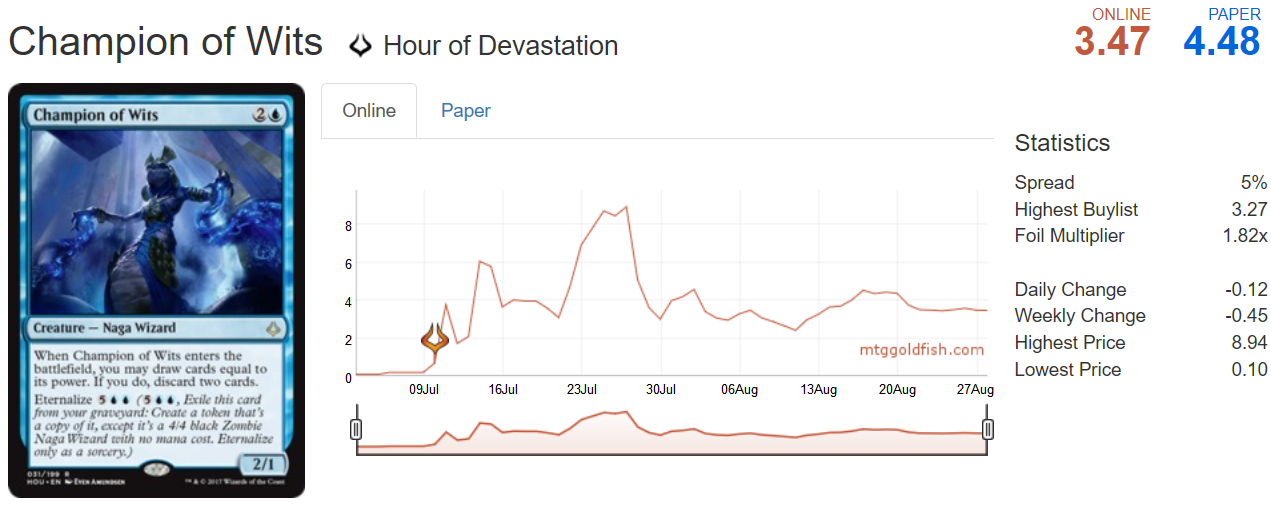
Champion of Wits has proven itself as a powerful enabler for graveyard-based strategies as well as a valuable midrange value creature. Abrade is currently keeping Champion of Wits's price in check by keeping God-Pharaoh's Gift strategies in check. Champion of Wits's potential is also high, standing to gain much from future Standard sets.
The graveyard is a popular focal point for Wizards R&D, one that is utilized every few blocks. While Ixalan does not seem to care about the graveyard, more likely than not, one of the next two sets/blocks will. If Champion of Wits becomes a core piece of a tier-one strategy enabled by cards from those sets, expect its price to reach 5.00 to 7.50 tix. I'm not enthusiastic about buying in at the current 3.50 tix price tag, but if it dips any lower, I'll be investing. An investment at 2.50 tix would likely be a smart, conservative buy.
Recommended buy price: 2.00 to 2.50 tix
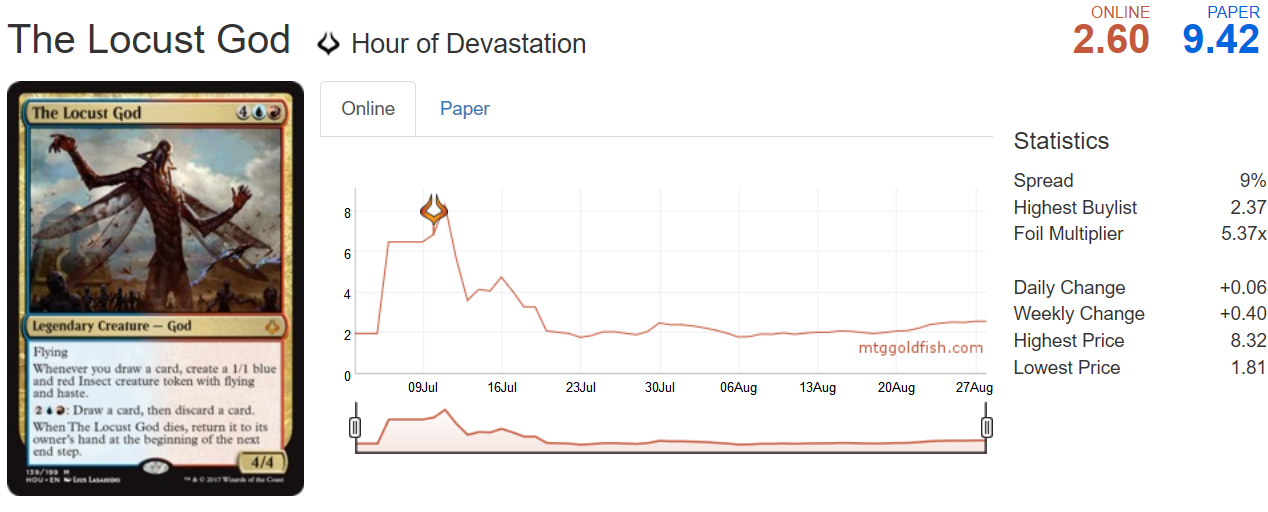
This is the one I'm sticking my neck out on, and hopefully the guillotine isn't what awaits it. The Locust God sees virtually no play, but it does meet certain important criteria. First is that it generates a lasting on-board advantage merely for existing (unlike the other two HOU gods, it needs only time, not mana). Second is that it is a sticky threat, and one that will become more sticky once Grasp of Darkness is replaced by Walk the Plank.
Winged divinities can walk planks all day. As such, I'm willing to risk financial capital on this speculation, even though it is possible that its converted mana cost of six and its needing time to generate lasting on-board advantage might prove too much to overcome. For those (understandably) hesitant, write this one down, and if no control finisher as good as this is revealed during spoiler season, consider investing in it at that time. Sphinx of the Final Word is rotating, after all!
Recommended buy price: 1.75 to 2.15 tix
Some Words of Caution
(1) The Scarab God
The Scarab God is a very interesting case study that I will use in a future article to highlight a truth: playing a format, and in this case, playing a particular deck (Temur Energy) in the format, can give you a huge leg up on the speculation competition.
When I first laid eyes on The Scarab God, I did not think I was looking at a card that was going to see a lot of competitive play, and I did not think I was looking at a card that would command a high price tag on MTGO. Powerful permanents like The Scarab God that don't generate a lasting advantage without additional effort generally don't rise to the level of Constructed viability – Drana, Liberator of Malakir, I'm looking at you – but it turns out that The Scarab God is just sticky enough and its activated ability creates just enough of an on-board advantage that it merits Constructed play.
Going forward, The Scarab God will likely see play in the maindeck and sideboards of various midrange and control strategies. Given its rarity and set as well as its set's paper multiplier discussed above, I think we have a card that could follow the price trajectory of Kalitas, Traitor of Ghet, even if shifted down several dollars. Kalitas, if you recall, flucturated between the high teens and mid thirties for much of its adult life in Standard.
The Scarab God is sitting at 12.99 tix right now, and I think that may prove to be a solid buy-in point. I admit that I'm still a little squeamish investing in it at that price point (man is a risk-averse creature. Take a look at this Royal Institute lecture on the historical relationship between gambling and mathematics for a few examples), but it looks more appealing when we consider that it is the most playable mythic rare in Hour of Devastation. A set's value has to park itself somewhere, at least until the redemption window closes in November. If this is a card you want to speculate on, it might be worth seeing if you can snag it around 10.00 tix. I might contemplate speculating on it closer to 8.00 or 9.00 tix.
(2) The Scorpion God
The Scorpion God is my favorite card from Hour of Devastation from a game design perspective. It trailblazes new design space for red in a way that expands the playability range of Magic's most narrow color. However, from the standpoint of Standard viability, it does not meet the playability bar that The Scarab God hurdles over. Three mana to give a creature -1/-1 pales in comparison to putting a 4/4 body into play for four mana. Additionally, it is a safe bet that no more cards synergistic with -1/-1 counters will be printed during its Standard life cycle (prior to Amonkhet, -1/-1 counter cards were last printed in Standard in 2011). Currently, The Scorpion God sits at 3.00 tix, and I don't see much growth potential.
(3) Nicol Bolas, God-Pharaoh
Nicol Bolas, God-Pharaoh currently sits at 6.90 tix, and I just don't think the card sees enough Constructed play or will see enough Constructed play in the future to hold that price tag. Cards with a converted mana cost of seven really need to win games of Magic or catch you up from behind when they land, and Nicol Bolas doesn't do either. Ugin, the Spirit Dragon or Dragonlord Atarka or Elspeth, Sun's Champion this is not. I expect Nicol Bolas to settle closer to 5.00 tix. There are always better speculation opportunities than seven-mana tri-colored cards.
Pixie-Dusting Away
As always, leave your thoughts in the comment section below. Remember to buy your shocklands and other Ravnica staples now due to the Flashback Drafts. I bought a playset of Chord of Calling and will be looking to fill out missing pieces in my shocklands as well. In my next article, I'll be finishing this series up with cheaper cards from Hour of Devastation, and then in the following article I will finish the series on what cards to speculate on in anticipation of rotation. I hope you enjoy the card below, the third in my cycle of mono-colored charms. Faerie players will love this one.
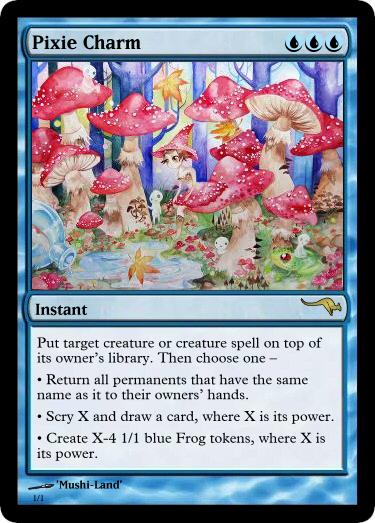


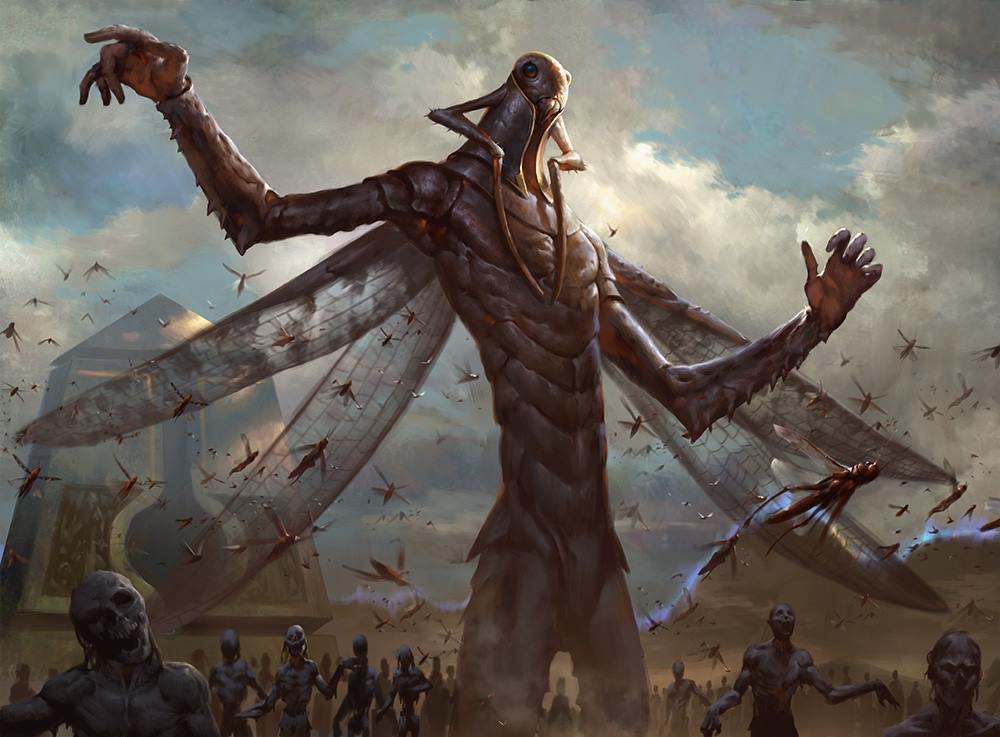





Hey Kyle,
Great article. Ive been doing some research on standard 5 drops, and what Ive concluded is that they do not behave in the same way that 4 drops do. I still need to do a bit more research, but generally 5 drops are good for 1 big spike then drift downward, although some do experience a late-in-their-standard-life spike, but many do not. So I wont expect scarab god to behave like Kalitas, which spiked at almost every pro tour. There is a ton of text on the scarab god with a recursion like ability so it could certainly defy the odds. I feel like Ishkanah is a really good comparison for the scarab god. I feel like 12 is really high, I will wait and see if I can get a lower buy price, and even then I will be looking to sell immediately at the first pro tour.
The problem I am having with the locust god is, how does it compete with Torrential Gearhulk? If I were building control, I assume it would be correct to go 4 torrential and 1 locust god, but on the other hand, why not just play the scarab god since its cheaper with that nice GY ability. At $2 tix there is less at stake, and could fluctuate regularly from commander play. So i’ll probably make a similar play to the scarab god.
Anyway I think my plan for now is to buy HOU sets minus the expensive mythics, and look to fill in the mythics when I can get good prices on them.
That’s an interesting line of research – investigating the price trajectories of cards at different CMCs to detect any definitive rules and trends regarding cards at certain CMCs. I was basing my comparison off of “function”, but you’re right that CMC plays an outsized role in a card’s financial potential.
I probably should have mentioned Torrential Gearhulk in the text of my article. I don’t think The Locust God needs to supplant Torrential Gearhulk. Merely finding its place as a one-of in a maindeck deck or sideboard in a control deck, or perhaps as a one of in a more permanent-based midrange or control deck, would lead to the card rising in value. I’m not willing to risk the current $2.50, but I think I’d like my odds if it dips to $2.00 or below.
I also want to mention: AKH and HOU are really good sets to redeem if you have the time and means to sell the physical cards. If I lived in the States I’d actually do it, but as it is I only come to the States a few times a year to visit family and friends, so I’m less inclined.
I can definitely see redemption being a good idea right now. The gods are instant commander hits, and Bolas isn’t far behind so I suspect that paper value should remain strong for the commander appeal. If im feeling patient maybe ill redeem a few sets.
Redemption is all about the paper multiplier, and Amonkhet Block is a slam dunk in this regard.